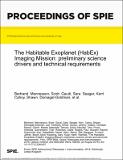The Habitable Exoplanet (HabEx) Imaging Mission: preliminary science drivers and technical requirements
Author(s)
Mennesson, Bertrand; Gaudi, Scott; Seager, Sara; Cahoy, Kerri; Domagal-Goldman, Shawn; Feinberg, Lee; Guyon, Olivier; Kasdin, Jeremy; Marois, Christian; Mawet, Dimitri; Tamura, Motohide; Mouillet, David; Prusti, Timo; Quirrenbach, Andreas; Robinson, Tyler; Rogers, Leslie; Scowen, Paul; Somerville, Rachel; Stapelfeldt, Karl; Stern, Daniel; Still, Martin; Turnbull, Margaret; Booth, Jeffrey; Kiessling, Alina; Kuan, Gary; Warfield, Keith; ... Show more Show less
Download99040L.pdf (512.8Kb)
PUBLISHER_POLICY
Publisher Policy
Article is made available in accordance with the publisher's policy and may be subject to US copyright law. Please refer to the publisher's site for terms of use.
Terms of use
Metadata
Show full item recordAbstract
HabEx is one of four candidate flagship missions being studied in detail by NASA, to be submitted for consideration to the 2020 Decadal Survey in Astronomy and Astrophysics for possible launch in the 2030s. It will be optimized for direct imaging and spectroscopy of potentially habitable exoplanets, and will also enable a wide range of general astrophysics science. HabEx aims to fully characterize planetary systems around nearby solar-type stars for the first time, including rocky planets, possible water worlds, gas giants, ice giants, and faint circumstellar debris disks. In particular, it will explore our nearest neighbors and search for signs of habitability and biosignatures in the atmospheres of rocky planets in the habitable zones of their parent stars. Such high spatial resolution, high contrast observations require a large (roughly greater than 3.5m), stable, and diffraction-limited optical space telescope. Such a telescope also opens up unique capabilities for studying the formation and evolution of stars and galaxies. We present some preliminary science objectives identified for HabEx by our Science and Technology Definition Team (STDT), together with a first look at the key challenges and design trades ahead.
Date issued
2016-08Department
Massachusetts Institute of Technology. Department of Earth, Atmospheric, and Planetary Sciences; Massachusetts Institute of Technology. Department of PhysicsJournal
Proceedings of SPIE
Publisher
SPIE
Citation
Mennesson, Bertrand et al. “The Habitable Exoplanet (HabEx) Imaging Mission: Preliminary Science Drivers and Technical Requirements
.” Edited by Howard A. MacEwen, Giovanni G. Fazio, Makenzie Lystrup, Natalie Batalha, Nicholas Siegler, and Edward C. Tong. Proceedings of SPIE: Space Telescopes and Instrumentation 2016: Optical, Infrared, and Millimeter Wave (August 2016): 99040L © 2016 SPIE
Version: Final published version
ISSN
0277-786X
1996-756X